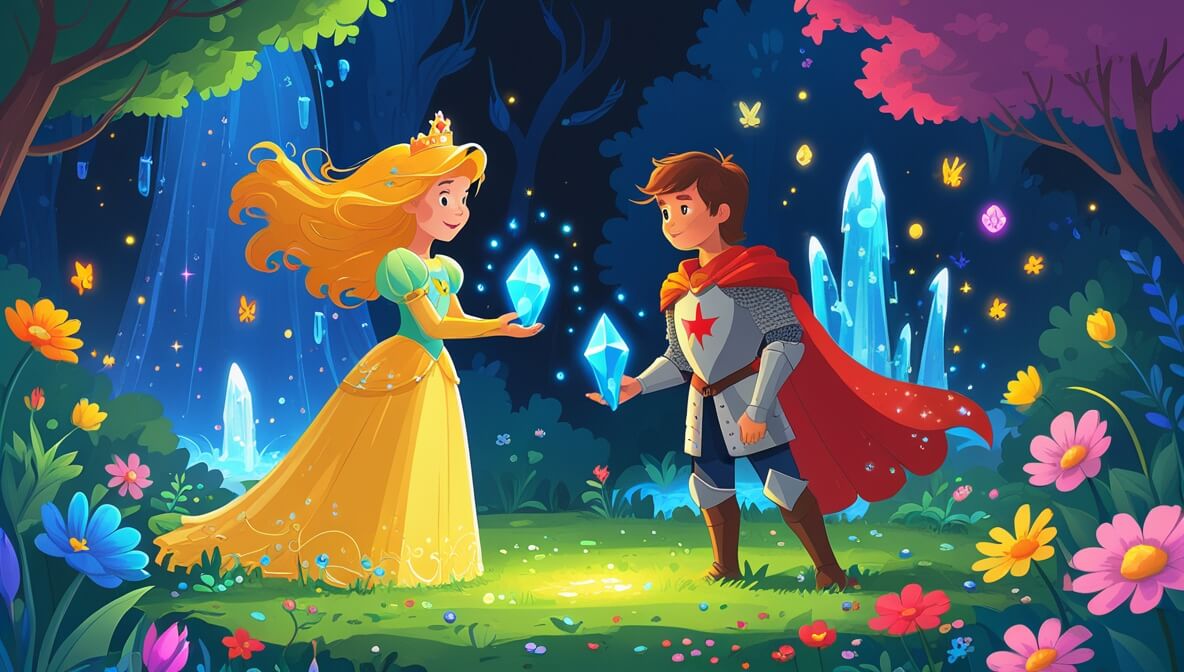In a magical kingdom, a brave princess embarks on a quest to save her enchanted garden and discovers a secret that changes everything.
Age Recommendation
3 – 12 years
Characters
Characters:
- Princess Aria (a curious and brave young princess who loves her magical garden)
- Sir Cedric (a loyal knight with a heart of gold)
- The Enchanted Garden (a magical place filled with talking flowers and sparkling fountains)
- Mystic the Wise Owl (a wise old owl who knows the secrets of the kingdom)
Story
Once upon a time in the Kingdom of Luminara, there was a princess named Aria. She was known for her love of the Enchanted Garden, a magical place where flowers spoke in whispers and fountains danced under the moonlight. One day, as Aria tended to her garden, she noticed that the flowers were wilting and the fountains had lost their sparkle.
The Mystery of the Enchanted Garden
Determined to save her beloved garden, Princess Aria decided to seek help from the kingdom’s wisest creature, Mystic the Wise Owl. As she approached the forest where Mystic lived, she felt a tingle of excitement mixed with worry. The path to the owl’s home was winding and filled with ancient trees that seemed to whisper secrets of their own.
Guidance from Mystic
When Princess Aria reached Mystic’s tree, the owl greeted her with a knowing smile. “Ah, Princess Aria,” Mystic hooted softly, “I have been expecting you. To save your garden, you must find the Crystal of Dreams, hidden deep within the Whispering Cave.” The owl’s words filled Aria with hope, but she knew the journey would be challenging.
Journey to the Whispering Cave
Accompanied by Sir Cedric, the bravest knight in the kingdom, Princess Aria set off on her quest. The path to the Whispering Cave was filled with magical creatures and enchanting sights. As they traveled, Aria and Cedric encountered a playful unicorn who offered them a ride, making their journey faster and more exciting.
The Secret of the Crystal
Finally, they reached the entrance of the Whispering Cave. The cave was dark and eerie, but as they ventured inside, Aria held tightly to her courage. At the heart of the cave, they found the Crystal of Dreams glowing with a soft blue light. Together, Aria and Cedric gently lifted the crystal, feeling its warmth and magic.
Restoring the Garden
With the crystal in hand, Princess Aria and Sir Cedric hurried back to the Enchanted Garden. As they placed the crystal in the center of the garden, a brilliant light filled the air. The flowers began to bloom again, and the fountains sparkled with joy. The garden was alive with magic once more, and Aria felt a deep sense of accomplishment.
The end.
Moral of the Story
The story teaches us the importance of courage and determination. Even when faced with difficult challenges, believing in oneself and seeking help can lead to wonderful outcomes. Princess Aria’s journey shows that true strength comes from within and that working together can overcome any obstacle.
Questions to Think About
- What do you think made Princess Aria so brave?
- How did Sir Cedric help Princess Aria on her journey?
- Why was the Crystal of Dreams important for the garden?
- What would you do if you found a magical garden?
- Can you think of a time when you helped someone solve a problem?
Do You Know
- Owls are often associated with wisdom in folklore and mythology because of their ability to see in the dark.
- In many cultures, unicorns are symbols of purity and grace.
Word Explorer
- Enchanted: Something that is magical or has special powers.
- Wilting: When a plant or flower droops because it needs water or care.
- Crystal: A clear, shiny stone that is often associated with magic.
Emotions in the Story
- Excitement: Felt by Princess Aria as she began her quest to save the garden.
- Worry: Aria felt this when she saw her garden wilting.
- Joy: Experienced by everyone when the garden was restored to its magical state.
Color Your Scene
Imagine the moment when Princess Aria places the Crystal of Dreams in the center of the garden. The flowers bloom with vibrant colors like pink, purple, and yellow, while the fountains sparkle with shimmering blue light. Draw this magical scene using your favorite colors and let your imagination run wild!
Parents’ Corner
This story is a great opportunity for parents to discuss important life skills with their children:
Courage and bravery: Encourage your child to share their own experiences of facing fears and how they overcame them.
Problem-solving and teamwork: Talk about how Princess Aria and Sir Cedric worked together to save the garden and how teamwork can be applied to real-life situations.
Appreciation for nature: Use the story as a way to teach the importance of taking care of the environment and the beauty of nature.
By discussing these themes, parents can help their children develop a deeper understanding of values and personal growth.











